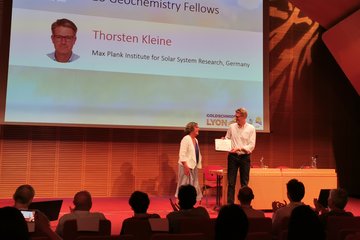Alle Typen
221.
Vortrag
Interchange process: Evidence for flow channels. Cassini MAPS workshop, Ann Arbor, USA (2016)
222.
Vortrag
Survey of pickup ion signatures at Titan using CAPS/IMS. CAPS/INMS team meeting, Grenoble, France (2016)
223.
Vortrag
Galactic Cosmic Rays in the inner magnetosphere of Saturn. European Geosciences Union General Assembly, Vienna, Austria (2015)
224.
Vortrag
Galactic Cosmic Rays tracing in the inner magnetosphere of Saturn. MIMI Team Meeting, Atlanta, Georgia, USA (2015)
225.
Vortrag
Enceladus flybys in the view of energetic particles. European Planetary Science Congress EPSC , Nantes, France (2015)
226.
Vortrag
Statistical analysis of the quasi-periodic relativistic electron injections in the Saturn's magnetosphere. Cassini PSG meeting #65, Rome, Italy (2015)
227.
Vortrag
Statistical analysis and multi-instrument overview of the quasi-periodic 1-hour pulsations in the Saturn's outer magnetosphere. Magnetospheres of the Outer Planets, Atlanta, Georgia, USA (2015)
228.
Vortrag
Global precipitation maps of energetic particles in Titan's atmosphere: T9 flyby. Cassini PSG Meeting 65, Rome, Italy (2015)
229.
Vortrag
Access of energetic particles to Titan's exobase: a study of Cassini's T9 flyby. Magnetospheres of the Outer Planets , Atlanta, Georgia, USA (2015)
230.
Vortrag
Plasma Energization in the Jovian System. European Planetary Science Congress EPSC, Cascais, Portugal (2014)
231.
Vortrag
Simulation of the Galactic Cosmic Rays interaction with Saturn;s atmosphere and rings. 40th COSPAR Scientific Assembly, Moscow, Russia (2014)
232.
Vortrag
Energetic particle tracing in the magnetosphere of Saturn. MIMI Team Meeting, Göttingen, Germany (2014)
233.
Vortrag
Global Flow Patterns in the Jovian Magnetosphere: Galileo/EPD and Galileo/PLS measurements. European Planetary Science Congress EPSC, Cascais, Portugal (2014)
234.
Vortrag
Measurements and modelling of the Jovian and Saturnian radiation belts (solicited). European Geosciences Union General Assembly 2014, Vienna, Austria (2014)
235.
Vortrag
Titan's magnetospheric environment. National Astronomy Meeting, Portsmouth, UK (2014)
236.
Vortrag
Titan's magnetospheric environment. 6th Alfven Conference, London, UK (2014)
237.
Vortrag
The mass of Saturn's main rings from energetic charged particle measurements. Planetary Seminar, Göttingen, Germany (2014)
238.
Vortrag
Quasi-Periodic injections of relativistic electrons in Saturn's magnetosphere. European Planetary Science Congress EPSC, Cascais, Portugal (2014)
239.
Poster
Studying the seed population of Saturn’s <1 MeV radiation belts using Cassini/MIMI measurements: Energetic Ion moments and polytropic index in Saturn’s magnetosphere. AGU Fall Meeting, San Francisco, CA, USA (2019)
240.
Poster
Weighted CRAND injection coefficients at Saturn. AGU Fall Meeting, San Francisco, CA, USA (2019)











